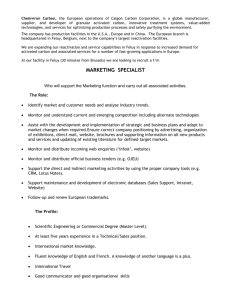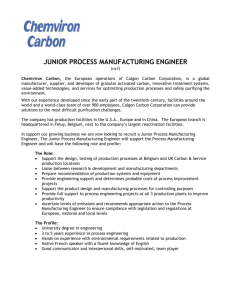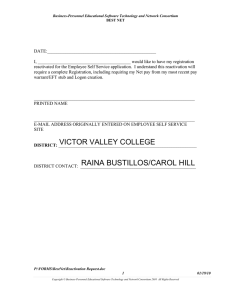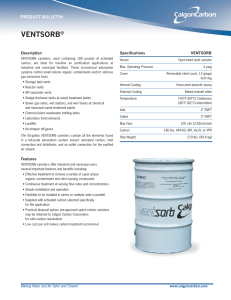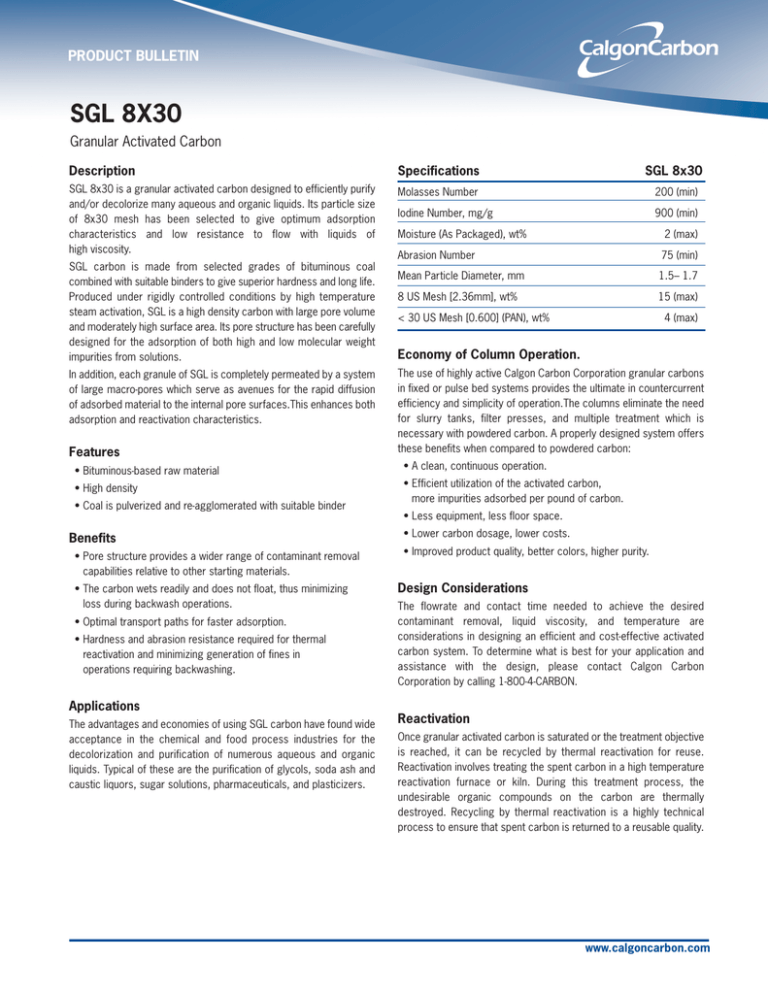
PRODUCT BULLETIN
SGL 8X30
Granular Activated Carbon
Description
Specifications
SGL 8x30
SGL 8x30 is a granular activated carbon designed to efficiently purify
and/or decolorize many aqueous and organic liquids. Its particle size
of 8x30 mesh has been selected to give optimum adsorption
characteristics and low resistance to flow with liquids of
high viscosity.
Molasses Number
200 (min)
Iodine Number, mg/g
900 (min)
SGL carbon is made from selected grades of bituminous coal
combined with suitable binders to give superior hardness and long life.
Produced under rigidly controlled conditions by high temperature
steam activation, SGL is a high density carbon with large pore volume
and moderately high surface area. Its pore structure has been carefully
designed for the adsorption of both high and low molecular weight
impurities from solutions.
In addition, each granule of SGL is completely permeated by a system
of large macro-pores which serve as avenues for the rapid diffusion
of adsorbed material to the internal pore surfaces.This enhances both
adsorption and reactivation characteristics.
Features
Moisture (As Packaged), wt%
2 (max)
Abrasion Number
75 (min)
Mean Particle Diameter, mm
1.5– 1.7
8 US Mesh [2.36mm], wt%
15 (max)
< 30 US Mesh [0.600] (PAN), wt%
4 (max)
Economy of Column Operation.
The use of highly active Calgon Carbon Corporation granular carbons
in fixed or pulse bed systems provides the ultimate in countercurrent
efficiency and simplicity of operation.The columns eliminate the need
for slurry tanks, filter presses, and multiple treatment which is
necessary with powdered carbon. A properly designed system offers
these benefits when compared to powdered carbon:
• Bituminous-based raw material
• A clean, continuous operation.
• High density
• Efficient utilization of the activated carbon,
more impurities adsorbed per pound of carbon.
• Coal is pulverized and re-agglomerated with suitable binder
• Less equipment, less floor space.
Benefits
• Pore structure provides a wider range of contaminant removal
capabilities relative to other starting materials.
• The carbon wets readily and does not float, thus minimizing
loss during backwash operations.
• Optimal transport paths for faster adsorption.
• Hardness and abrasion resistance required for thermal
reactivation and minimizing generation of fines in
operations requiring backwashing.
• Lower carbon dosage, lower costs.
• Improved product quality, better colors, higher purity.
Design Considerations
The flowrate and contact time needed to achieve the desired
contaminant removal, liquid viscosity, and temperature are
considerations in designing an efficient and cost-effective activated
carbon system. To determine what is best for your application and
assistance with the design, please contact Calgon Carbon
Corporation by calling 1-800-4-CARBON.
Applications
The advantages and economies of using SGL carbon have found wide
acceptance in the chemical and food process industries for the
decolorization and purification of numerous aqueous and organic
liquids. Typical of these are the purification of glycols, soda ash and
caustic liquors, sugar solutions, pharmaceuticals, and plasticizers.
Reactivation
Once granular activated carbon is saturated or the treatment objective
is reached, it can be recycled by thermal reactivation for reuse.
Reactivation involves treating the spent carbon in a high temperature
reactivation furnace or kiln. During this treatment process, the
undesirable organic compounds on the carbon are thermally
destroyed. Recycling by thermal reactivation is a highly technical
process to ensure that spent carbon is returned to a reusable quality.
www.calgoncarbon.com
Typical Pressure Drop
Bed Expansion During Backwash
SGL 8x30 with Water
35
48°F
30
oise
entip
10 c
ise
ntipo
4 ce ipoise
nt
2 ce ipoise
nt
1 ce
ise
tipo
cen
8
.
0
10
1
25
% Expansion
Pressure Drop – Inches H2O/ft Bed
100
70°F
20
15
10
.01
5
0.01
0.1
0.2
0.5 0.8 1
2
Velocity – GPM / ft2
3
4 5 6 7 8 9 10
0
0
2
4
6
8
Superficial Velocity – (gpm/sf)
10
12
Pressure Drop Curve
Safety Message
The pressure drop per foot of bed depth for SGL carbon for varying
flow rates at different viscosity levels is illustrated. This data was
obtained in down-flow column operation with a normal packing
arrangement in which the carbon was pre-soaked in hot liquid and
charged to the column as a slurry.The bulk density of the charged
carbon was calculated to be approximately 30 lb/ft3.
Wet activated carbon preferentially removes oxygen from air. In closed
or partially closed containers and vessels, oxygen depletion may reach
hazardous levels. If workers are to enter a vessel containing carbon,
appropriate sampling and work procedures for potentially low oxygen
spaces should be followed, including all applicable federal and state
requirements. Please refer to the MSDS for all up to date product
safety information.
Packaging
Please contact Calgon Carbon for options and availability.
www.calgoncarbon.com
Corporate Headquarters
Calgon Carbon Corporation
500 Calgon Carbon Drive
Pittsburgh, PA USA 15205
800.422.7266
412.787.6700
412.787.6713 Fax
European Operations
ChemvironCarbonCorporation
ZoningIndustrielCdeFeluy
B-7181Feluy,Belgium
+32(0)64511811
+32(0)64541591Fax
www.calgoncarbon.com
Copyright© 2014 Calgon Carbon Corporation, all rights reserved.
Asia Operations
CalgonCarbonAsiaPteLtd.
9TemasekBoulevard
#26-02SuntecTowerTwo
Singapore038989
+6562213500
+6562213554Fax
Your local representative
0114

